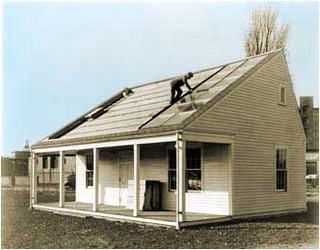The following buildings are of significance in pioneering the use of solar powered building design:
- MIT Solar House #1, Massachusetts, United States (Hoyt C. Hottel & others, 1939)[1][2][3]
- Howard Sloan House, Glenview, Illinois, United States (George Fred Keck, 1940)[1][4]
- "Solar Hemicycle", near Madison, Wisconsin, United States (Frank Lloyd Wright, 1944)[1][5]
- Löf House, Boulder, Colorado, United States (George Löf, 1945)[1][2][6]
- Rosenberg House, Tucson, Arizona, United States (Arthur T. Brown, 1946)[1][7]
- MIT Solar House #2, United States, (Hoyt C. Hottel & others, 1947)[1][8]
- Peabody House ("Dover Sun House", MIT Solar House #6), Dover, Massachusetts, United States (Eleanor Raymond & Mária Telkes, 1948)[1][2][8]
- Henry P. Glass House, Northfield, Illinois, United States (Henry P. Glass, 1948)[9][10]
- Rose Elementary School, Tucson, Arizona, United States (Arthur T. Brown, 1948)[1][7]
- MIT Solar House #3, United States, (Hoyt C. Hottel & others, 1949)[1][2][8]
- New Mexico State College House, New Mexico, United States (Lawrence Gardenhire, 1953)[8][citation needed]
- Lefever Solar House, Pennsylvania, United States (HR Lefever, 1954)[8][citation needed]
- Bliss House, Amado, Arizona, United States (Raymond W. Bliss & M. K. Donavan, 1954)[1][8]
- Solar Building, Albuquerque, New Mexico, United States (Frank Bridgers & Don Paxton, 1956)[1][11]
- University of Toronto House, Toronto, Ontario, Canada (EA Allcut, 1956)[8][citation needed]
- Solar House, Tokyo, Japan (Masanosuke Yanagimachi, 1956)[1][8]
- Solar House, Bristol, United Kingdom (L Gardner, 1956)[8][citation needed]
- Curtis House, Rickmansworth, United Kingdom (Edward JW Curtis, 1956)[12]
- Löf House, Denver, Colorado, United States (James M. Hunter & George Löf, 1957)[1][13]
- AFASE "Living With the Sun" House, Phoenix, Arizona, United States (Peter Lee, Robert L. Bliss & John Yellott, 1958)[1]
- MIT Solar House #4, United States (Hoyt C. Hottel & others, 1958)[1][2][8]
- Solar House, Casablanca, Morocco (CM Shaw & Associates, 1958)[1][8][citation needed]
- Solar House, Nagoya, Japan (Masanosuke Yanagimachi, 1958)[1][8]
- Curtiss-Wright "Sun Court," Princeton, New Jersey, United States (Maria Telkes & Aladar Olgyay, 1958)[1]
- "Sun-Tempered House" Van Dresser Residence (Peter van Dresser, 1958)
- Thomason Solar House "Solaris" #1, Washington D.C., United States (Harry Thomason, 1959)[1][14]
- Passive Solar House, Odeillo, France (Félix Trombe & Jacques Michel, 1967)[1][15]
- Steve Baer House, Corrales, New Mexico, United States (Steve Baer, 1971)[1][16][17]
- Skytherm House, Atascadero, California, United States (Harold R. Hay, 1973)[1][18][19]
- Solar One, Newark, Delaware, United States (K.W. Böer & Maria Telkes, 1973)[1]
- MIT Solar Building V, Cambridge, Massachusetts, United States (T.E. Johnson, C.C. Benton, S. Hale, 1978)[20][21]
- "Unit One" Balcomb Residence, Santa Fe, New Mexico, United States (William Lumpkins, 1979)
- The first Zero Energy Design home, Oklahoma, United States (Larry Hartweg, 1979)[22][citation needed]
- Saunders Shrewsbury House, Shrewsbury, Massachusetts, United States (Norman B. Saunders, 1981)[1][23]
- Multiple IEA SHC "Task 13" houses, Worldwide (IEA SHC, 1989)
- Multiple passive houses in Darmstadt, Germany (Bott, Ridder & Westermeyer, 1990)[24]
- Heliotrope, Freiburg im Breisgau, Germany (Rolf Disch, 1994)[25]
- The Druk White Lotus School, Ladakh, India (Arup, 2002)[26]
- 31 Tannery Project, Branchburg, New Jersey, United States (2006)
- Sun Ship, Freiburg im Breisgau, Germany (Rolf Disch, 2006)[25]
 M.I.T. Solar House #1
M.I.T. Solar House #1
Boyce, Robert (1993). Keck & Keck: The Poetics of Comfort. Princeton, NJ: Princeton Architectural Press. ISBN 1-878271-17-2. Henry P. Glass and World War II, MIT Design Issues: Volume 22, Number 4 Autumn 2006
Johnson, Timothy E. (1981), "MIT solar building No. 5: the third year performance", Passive Sol. J.; (United States), 1:3, OSTI 6560657
